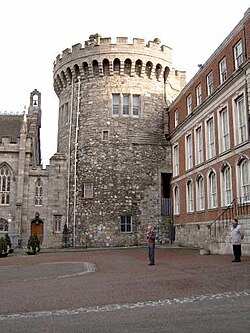The Court of Castle Chamber (which was sometimes simply called Star Chamber) was an Irish court of special jurisdiction which operated in the sixteenth and seventeenth centuries.
It was established by Elizabeth I of England in 1571 to deal with cases of riot and public order crime generally, and all crimes which threatened the security of the Crown. It was explicitly modelled on the English Court of Star Chamber, and it was often referred to as Star Chamber.[1] It took its name from the chamber (which no longer exists) which was specially built for it in Dublin Castle, situated over the main gate.
The Court of Castle Chamber in its early decades was, like Star Chamber, popular with members of the public who, under the guise of complaining about cases of riot or public disorder, brought their private lawsuits to Castle Chamber, which was often swamped with private business as a result. Nonetheless, its jurisdiction to hear private cases was often questioned and was not confirmed until 1634, a few years before it ceased to operate. Its popularity was seemingly unaffected by the fact that it was notoriously ineffective in enforcing its decrees.
In the seventeenth century, Castle Chamber, like its English counterpart, was seen by the Stuart dynasty as a suitable instrument for enforcing government policy and it became highly unpopular as a result. Its use by Thomas Wentworth, 1st Earl of Strafford, who as Lord Lieutenant of Ireland (1632-1640) was virtually all-powerful in that Kingdom, as the principal instrument for subduing the king's political opponents, was one of the principal reasons for his downfall and execution in 1641.[2] During the political upheaval caused by the Irish Rebellion of 1641, the court simply ceased to operate, although there is no record that it was ever formally abolished. It was not revived after the Restoration of 1660.
